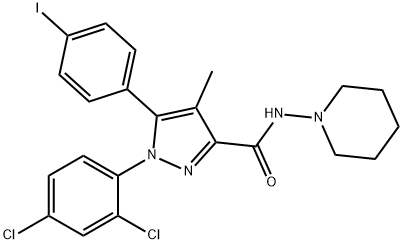183232-66-8
 183232-66-8 結構式
183232-66-8 結構式
基本信息
1-(2,4-二氯苯基)-5-(4-碘苯基)-4-甲基-N-1-哌啶基-1H-吡唑-3-甲酰胺
1-(2,4-二氯苯基)-5-(4-碘苯基)-4-甲基-N-(哌啶-1-基)-1H-吡唑-3-甲酰胺
AM 251
CS-985
AM 251 NEW
AM-251 ,99%
AM251
AM-251
AM 251 (pharmaceutical)
1-(2,4-dichlorophenyl)-5-(4-iodophenyl)-4-methyl-N-piperidin-1-ylpyrazole-3-carboxamide
1-(2,4-DICHLOROPHENYL)-5-(4-IODOPHENYL)-4-METHYL-N-1-PIPERIDINYL-1 H-PYRAZOLE-3-CARBOXAMIDE
1H-Pyrazole-3-carboxamide, 1-(2,4-dichlorophenyl)-5-(4-iodophenyl)-4-methyl-N-1-piperidinyl-
物理化學性質
安全數(shù)據(jù)
常見問題列表
IC50: 8 nM (CB1 receptor)
AM251 is a CB1 receptor antagonist/inverse agonist. AM251 produces an agonist response in HEK293 cells, similar to that found in the yeast expression system. AM-251 reduces cholesteryl ester synthesis in unstimulated and acetylated LDL-stimulated Raw 264.7 macrophages, CB2 +/+ and CB2 -/- peritoneal macrophages.
The CB1 antagonist AM251 (3 mg/kg, i.p.) decreases capsaicin-evoked nocifensive behavior (F 1,18 =28.45, p<0.0001). This suppressive effect is genotype dependent (F 1,18 =14.83, p<0.01), and the interaction between the effects of genotype and AM251 approached significance (F 1,18 =4.704, p=0.0587). Planned comparisons reveal that AM251 reduces nocifensive behaviors in fatty-acid amide hydrolase (FAAH) KO mice (p<0.01) but fails to alter nocifensive behavior in WT mice (p>0.2) relative to their respective vehicle controls. AM251 (3 mg/kg, i.p.) reduces the duration of heat hypersensitivity in FAAH KO (F 1,9 =21.43, p<0.01) but not WT mice (p>0.3). AM251 suppresses capsaicin-evoked heat hypersensitivity in a time-dependent manner in FAAH KO (F 5,9 =4.349, p<0.01) but not in WT mice (p>0.3). Post-hoc analysis reveals that FAAH KO mice receiving vehicle (i.p.) display heightened thermal hypersensitivity at 30 (p<0.05), 60 (p<0.05), and 90 (p<0.001) minutes post-capsaicin in comparison to FAAH KO animals receiving AM251). One-way ANOVA shows that AM251 (AM-251) injected into the rats significantly decreases both of the percentage of entries in the open arms and time spent in the open arms, compare to controls. The Tukey-Kramer test analysis reveals a significant reduction for the doses of 1 mg/kg (P<0.05) and 5 mg/kg (P<0.01) compare to control rats in the time spent in the open arms. Also, AM251 significantly decreases percentage of entries in the open arms for the doses of 1 and 5 mg/kg (P<0.05).
